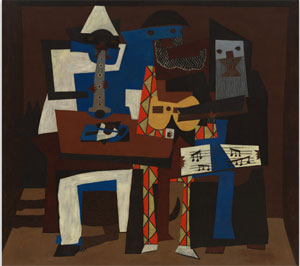2.16.24 — A Summer Away from Cubism
What do you do as a follow-up after inventing modern art? Do you take the summer off or reinvent yourself?
Pablo Picasso pulled off both. He and his young family rented a villa in Fontainebleau, a privileged Parisian’s weekend or summer getaway. Kings had stayed at a palace still worth seeing and hunted in the forest nearby. This artist, though, never could stop working, and he turned out two of his most ambitious paintings, each in two remarkably different versions. Just to focus on them with a bit of context would be an excellent excuse for a show,  and “Picasso in Fontainebleau” supplies it, at the Museum of Modern Art through February 17. It also offers the occasion to ask what had changed since Cubism and whether he was still breaking ground in 1921. Meanwhile the Met sees his breakthrough work not quite making it to Brooklyn, and I work an earlier report on that together with a longer and fuller version of this one as a longer review and my latest upload.
and “Picasso in Fontainebleau” supplies it, at the Museum of Modern Art through February 17. It also offers the occasion to ask what had changed since Cubism and whether he was still breaking ground in 1921. Meanwhile the Met sees his breakthrough work not quite making it to Brooklyn, and I work an earlier report on that together with a longer and fuller version of this one as a longer review and my latest upload.
A lot had changed in ten years, since those designs for Brooklyn failed to cross the Atlantic. The artist whose shows had looked revolutionary but sold almost nothing now had a prestigious dealer, Paul Rosenberg. He had a young wife, Olga, who was nursing his first child, Paul (bottle fed, by the way). He had a summer rental in the land of kings. Paintings and drawings of home were a celebration. Compulsive sketches attest to a love of drawing and close observation, but surely they were a celebration, too.
And then there were the big paintings, nearly eight feet tall and six feet wide. MoMA does its best to recreate the space in which he worked, a garage, where the two versions of Three Musicians face each other down from opposite walls. They seem more playful and deadly serious every day. The three figures share flat, broken fields of color, like playing cards, and one shuffles the musical score like cards, too. They could be staring out from behind masks, except that they are too polite and too absorbed to stare. They are too busy playing music and at play.
Or are they empty masks? The threat of emptiness looms over them all, especially with the darker version in the museum’s own collection. Art, it suggests, is role play with no one left to play the roles, and these are old roles indeed. The three musicians are a Pierrot out of the Italian commedia dell’arte, a harlequin, and a monk. A fourth character lurks all the more in shadow, the silhouette of a dog. The second version, on loan from the Philadelphia Museum, is lighter in color and maybe in feeling, and the figures sport comic mustaches, but Pablo Picasso developed them together.
A third work should be familiar from MoMA, too, its version of Three Women at the Spring. Picasso was thinking in threes, for a binary choice was never enough. He has set the women at ease, standing, kneeling, and seated—if only you could altogether reconstruct their pose. They have all the space they need, but barely, for their rounded forms need plenty. Their six hands talk to each other as well, in a wild conversation. Their bodies have an earthy dignity, but their emotions do not so easily break through.
So where was Picasso headed, to a Cubism on overdrive or to a Neo-Classicism? As with Henri Matisse and his Red Studio last year, MoMA places an early modern artist in a new studio and watches the sparks fly. Both artists were looking back at their own work in new surroundings. Picasso knew that the collaborative spirit of Cubism was over, and he must have wondered if Cubism’s experimental spirit was behind him as well. Should he lend it a greater stability, mystery, and color or ditch it entirely—and could he reimagine the heavyset women of his Pink Period, too? Two pairs of two multiply the possibilities.
Read more, now in a feature-length article on this site.